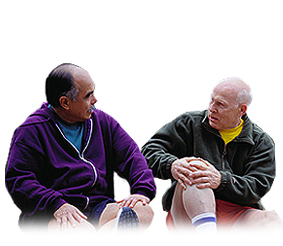Knee Pain SmartSiteTM | ||||||||||||||||||
Knee injuriesMeniscus tearsThe meniscus is a firm, rubbery piece of cartilage in the knee. It lies between your thigh bone and your shin bone. The meniscus acts as a shock absorber to protect the articular cartilage. Articular cartilage is the tough but smooth tissue that covers the ends of the bones in your knee. This allows the joint to glide smoothly. Your meniscus also helps keep the knee joint stable. A tear in the meniscus may happen suddenly during activity. Other times, a small tear may be present without any symptoms at first. Pain and other symptoms can get worse as the tear in the meniscus gets larger. Some symptoms of a meniscus tear are:
Most of the time, a meniscus tear that is causing symptoms will need to be addressed with surgery. This is done using knee arthroscopy. Ligament injuriesLigaments are thick bands of tissue that help hold the knee joint together and keep it stable. Their job is to make sure the bones in your knee joint move only in certain directions. There are two important pairs of ligaments in the knee:
These ligaments may be sprained, partially torn, or completely torn and separated. Ligament injuries may be caused by:
Most of the time, you will notice symptoms right away after an injury to these ligaments. Most of the time, you won't be able to continue with sports after the injury. You may have:
People who have only a mild injury may not notice symptoms at first. Over time, the knee may feel unstable or seem to give way when using it. Unstable kneecapYour kneecap (patella) sits in the front of your knee joint. As you bend or straighten your knee, the underside of the patella glides in a groove in the thigh bone that makes up the knee. When the groove in the bone is not deep enough or when the ligaments holding the kneecap are torn, the kneecap can slide out of place. If you have an "unstable" kneecap, the kneecap may move too much from side to side. Symptoms you may notice are:
Your kneecap may also become completely pushed to the outside of the knee. This is called a dislocated patella. Symptoms of this are:
If your kneecap dislocates, your doctor will help put the kneecap back in place. Then your knee will be placed into a knee immobilizer to prevent you from moving it for several weeks (usually about 3 weeks). After that, physical therapy can help you build back your muscle strength and improve your knee's range of motion and stability. If your knee remains unstable, you may need surgery to stabilize your kneecap. This may be done using arthroscopic or open surgery. | ||||||||||||||||||
| ||||||||||||||||||
Review Date: 8/9/2018 Reviewed By: C. Benjamin Ma, MD, Professor, Chief, Sports Medicine and Shoulder Service, UCSF Department of Orthopaedic Surgery, San Francisco, CA. Also reviewed by David Zieve, MD, MHA, Medical Director, Brenda Conaway, Editorial Director, and the A.D.A.M. Editorial team. View References:  The information provided herein should not be used during any medical emergency or for the diagnosis or treatment of any medical condition. A licensed medical professional should be consulted for diagnosis and treatment of any and all medical conditions. Links to other sites are provided for information only -- they do not constitute endorsements of those other sites. No warranty of any kind, either expressed or implied, is made as to the accuracy, reliability, timeliness, or correctness of any translations made by a third-party service of the information provided herein into any other language. © 1997- A.D.A.M., a business unit of Ebix, Inc. Any duplication or distribution of the information contained herein is strictly prohibited. | ||||||||||||||||||
A.D.A.M. content is best viewed in IE9 or above, Firefox and Google Chrome browser. | ||||||||||||||||||












